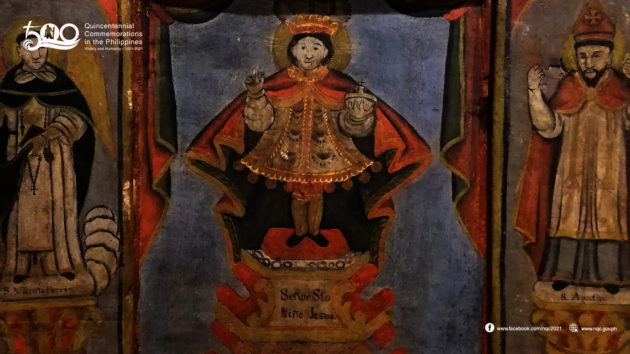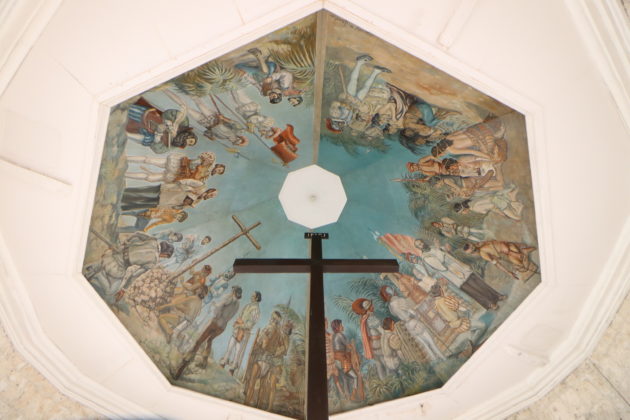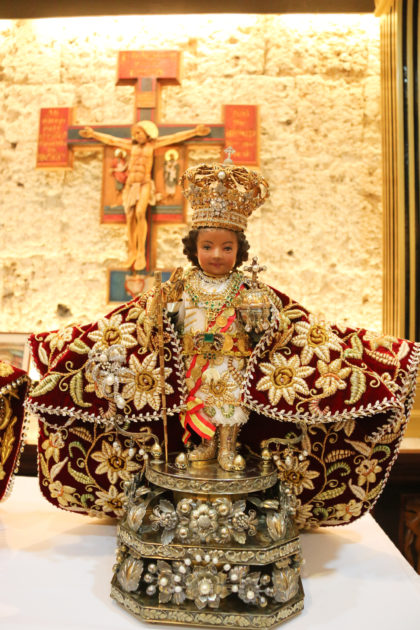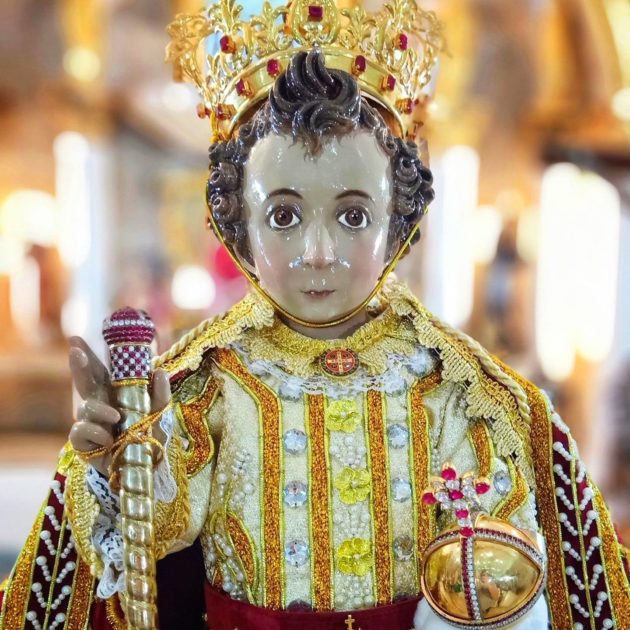Why Filipinos Love the Santo Niño
Posted on 10 January 2021
By Xiao Chua

On 9 April 1521, two days after the Magellan-Elcano expedition reached Cebu, Ferdinand Magellan enticed the rulers of Cebu that to be a Christian was to be an ally of the most powerful king in the world (i.e., Spanish King). According to Antonio Pigafetta, chronicler of Magellan, around 800 of our ancestors in Cebu were baptized as Christians. Among them was the chief of Cebu himself, Rajah Humabon, and his wife, who was christened Juana. Magellan ordered the new converts to destroy their idols and shrines along the shore. To refocus our ancestors’ spiritual life to Christianity, Magellan presented Juana with a 15-centimeter image of the child Jesus, the Santo Niño.
That event in 1521 marked the introduction of Christianity in the Philippines. Eventually, the Philippines became one of the bastions of Christianity in Asia, and the Santo Niño gains a special role in the heart of the Filipinos, particularly among the Roman Catholic faithful.

Devotion to the Santo Niño
The devotion to the Santo Niño in the Philippines flourished spontaneously when the Spaniards led by Miguel Lopez de Legazpi promoted it in 1565. After they captured Cebu on 28 April 1565, the Spaniards discovered the image believed to be the one presented by Magellan in Cebu 44 years earlier. Describing the image as “like those of Flanders,” Legazpi interpreted the discovery as divine providence. Later in their conquest, similar providential discoveries by the Spaniards were made, like in 1571, when they discovered in Manila the image of the Virgin Mary. Historian Ambeth Ocampo is critical of these narratives, saying that the Spaniards could have only justified their presence in this part of the world. For historian Jaime Veneracion, these occurrences in the nascent Spanish colonization were products of their time, when Spain was in the age of mysticism marked by the belief of the Spaniards that their god willed their triumphs.
500 Years of Christianity | Santo Niño of Cebu
On 9 April 1521, two days after the Magellan-Elcano expedition reached Cebu, Ferdinand Magellan enticed the rulers of Cebu that to be a Christian was to be a…
Contrary to popular belief, Christianization of the Philippines began not in 1521 but in 1565. It was in that year that the first missionaries evangelized Christianity in the archipelago. For historical reckoning, the National Quincentennial Committee branded the 1521 event as the introduction of Christianity in the Philippines. Nonetheless, the first missionaries sustained the reverence of our ancestors in Cebu to the Santo Niño since 1521 by preaching them the Christian faith. From then on, the said missionaries popularized the historic Santo Niño in various parts of the Visayas and Luzon. In fact, the Santo Niño became the patron saint of Tondo, the first Christian parish in Luzon. Even the Christian inhabitants of the Maluku, especially Ternate (both part of Indonesia today), who were evacuated by the Spaniards to Cavite in the mid-17th century, venerated the Santo Niño as their patron saint. Eventually, these people from Ternate established their own town, named after their hometown in Indonesia, and installed their centuries-old Santo Niño from Indonesia as their patron saint.
According to anthropologist Rosa C P. Tenazas, the devotion to the Santo Niño in the Philippines can be divided into two centers: the primary center based in Cebu with influence in Bohol, Leyte, Samar, Negros, and Iloilo; and the secondary centers based in Manila with influence in Tondo, Pandacan, Makati, and Bulacan.

The Filipino in the Santo Niño Devotion
Anthropologist Peter J. Bräunlein explained that the Filipinos’ “affection” for the Santo Niño was brought about by our fondness for children and “rubbing and pinching babies.” This may explain the “rubbed nose and the peeled-off part” of the face of Cebu’s Santo Niño. Also connected to this is our custom of touching or kissing the face, hands, or feet of a sacred image.
Although devotion to the Santo Niño also developed in Europe, particularly in Prague, in the 17th century, the devotion to the Santo Niño in the Philippines is completely organic and local to us, Filipinos. Philippine devotion to the Santo Niño progressed from the fusion of Christianity and the indigenous belief system of our ancestors, the one thing the Spanish missionaries failed to prevent, despite their stern eradication of old unchristian practices. According to Bräunlein:
Starting with the first encounter, the foreign Santo Niño was treated as an orphaned deity. The survival of the image in the indigenous setting, free of missionary control for over 44 years, favored the unique potential of the image to be appropriated and translated into local contexts for diverse spiritual needs and purposes.
Bräunlein’s theory is supported by the reports of Legazpi and his men about the discovery of the image of the Santo Niño in Cebu. It was found placed in a chest full of flowers in a house, proof that it was venerated as a deity by our ancestors. Still, according to Bräunlein, our ancestors “highly appreciated” the Santo Niño after the Magellan-Elcano expedition left because of its “resemblance to the traditional idols, called tao-tao (manikin), bata bata (great-grandparent) or larawan (image, mold, model).” Even the dance for the Santo Niño of Cebu called sinulog, from the root word Cebuano “sulog” or wave, has an ancient flavor. The dance mimics the sea waves to the beat of the drums. The sinulog is a rite for asking favors (sangpit) to the Senyor (nickname of the Santo Niño). While holding a candle, the dancer shouts out the name of the one he or she is dancing for, followed by “Pit Senyor!”
Aside from Cebu, there is also a dance for the Santo Niño in Kalibo, Aklan called ati-atihan derived from the war dance of the Ati, marked by the crying of “hala-bira.” In Pandacan, Manila, the dance for the Santo Niño is called buling-buling.
Devotion and Revolution
Even the Cebuanos’ participation in the Philippine Revolution in 1898 was characterized by the devotion to the Santo Niño. On Palm Sunday, 3 April 1898, around 5,000 Cebuano revolutionaries led by Pantaleon “Leon Kilat” Villegas attacked the Spanish military installation in Cebu, crying “Mabuhi ang Katipunan! Mabuhi ang Santo Niño!” (Long live the Katipunan! Long live the Santo Niño!).
After the Philippine-American War, the nationalist Iglesia Filipina Independiente, also known as Aglipayan Church, attracted a number of followers. This was brought about by the disenchantment of patriotic Filipinos in the friars and the failure of the secularization of churches in the Philippines. Among the leading supporters of the Aglipayan church was Ternate, Cavite, whose patriotic Municipal Government officials seized the keys of the Ternate Church from its Spanish parish priest. According to these officials, the Ternate Catholic faithful had the authority over the Ternate Church and the Santo Niño image brought by their ancestors from Indonesia.

Another instance of the link between the Santo Niño and the Katipunan was cited by National Artist Nick Joaquin. Joaquin once wrote that it was a custom during the feast of Santo Niño in Tondo for women to wear “Katipunera” attire, consisting of a red blouse, white shirt, and a peasant’s hat.
The Santo Niño in the Time of Naruto
For several centuries, the Santo Niño has been part of the Filipinos’ everyday life. Its image can be seen today in jeepneys, UV express vans, inside the bag of board exam takers, on the altars of homes, airport lounges, and offices. Filipinos also love to dress up the Santo Niño according to them in various professions and personalities: as a police officer, a press member, security guard, tailor, chemist, beggar, and Naruto.
Today, devotees regularly flock to the feast of the Santo Niño. The feast day of the Santo Niño is usually celebrated in January. Ternate celebrates first every 8-9 January. Cebu and Tondo come next every third Sunday of the month. While Iloilo City—where the Santo Niño feast is called the Dinagyang—celebrates every fourth Sunday of January.
It is neither surprising that the Santo Niño had a place in big celebrations of the Catholic Church in the past, such as during the 3rd National Eucharistic Congress held in time for the 400th anniversary of the Christianization of the Philippines from 28 April – 2 May 1965; and the 51st International Eucharistic Congress on 15 January 2016, both events held in Cebu.
About the Author
MICHAEL CHARLESTON “XIAO” CHUA is a public historian and Assistant Professorial Lecturer of History at the De La Salle University Manila. He is the author of a number of refereed academic journals and a columnist at the Manila Times and Abante. He was the creator of Xiao Time, the history segment of the government television station.

